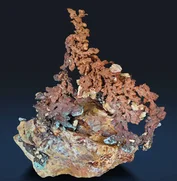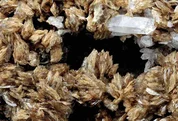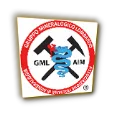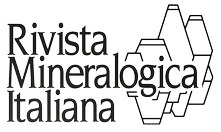Abstract 2024
Rivista Mineralogica Italiana > Abstract Articoli
Abstract ITALIAN MINERALOGICAL MAGAZINE nr. 1-2024 | ||||||
TINZENITE THE FINDINGS FROM THE Mn ORE DEPOSITS OF EASTERN LIGURIA  | The Mn ore deposits of Eastern Lig- uria are well-known for several mineral species, in some cases occurring in aesthetic specimens. Among them, tinzenite forms classic specimens actively sought by mineral collectors. This mineral belongs to the axinite group, along with axinite-(Fe), axinite-(Mg), and axinite-(Mn). Its troubled definition and its relations with the other members of the axinite group are briefly reviewed. It is worth noting that tinzenite was misidentified as spessartine by Alberto Pelloux in 1919, four years earlier the first description from the Swiss locality of Tinzen, Grisons. Samples of tinzenite from Liguria were later used for the investigation of the crystal chemistry of this mineral that has been recently redefined with the ideal end-member formula Ca Mn Al [B Si O ](OH) . Tinzenite has been found in several ore deposits of the Graveglia Val- ley, i.e., those formerly exploited by the Gambatesa, Cassagna, Molinello, Statale/Scrava and Monte Bossea mines. Tinzenite occurs as veins hosted in braunite or cherts, in some cases characterized by cavities lined by lenticular crystals, showing colour ranging from salm- on-pink to yellow to orange. Associated minerals are calcite, caryopilite, chalcocite, clinochlore-pennantite, cuprite, gamagarite, ganophyllite, harmotome, hematite, kutnohorite, marcasite, piemontite, quartz, rhodochrosite, and sursassite. In this paper, the most significant findings of the last fifty years are summarized. In the upper part of the Molinello mine, during the 1970s, some nice findings were performed by local miners, who collected specimens where tinzenite is associated with quartz and sursassite. A specimen representative of these findings is currently kept in the Natural History Museum “Giacomo Doria” in Genoa. In the second half of the 1980s, the open-pit works at the Cassagna mine allowed the find ing of a vein of tinzenite, up to 10 cm in thickness, with some cavities lined with tinzenite and quartz crystals. Unusual specimens with a salmon-pink colour were collected from this locality. At the end of 1989, a couple of well-crystallized specimens were extracted from a tinzenite vein hosted in the braunite ore from the Monte Bossea mine. However, the most important finding was performed in 2002 at the Molinello mine. Several beautiful specimens were collected, showing aesthetic aggregates of crystals of tinzenite associated with quartz and sursassite. At this same locality, new findings have been performed recently. Tinzenite is reported in nice specimens from other minor ore deposits of Eastern Liguria (e.g.,Monte Alpe and Colli di Tavarone). | |||||
NATIVE COPPER OF EASTERN LIGURIA  | ||||||
AXINITE-(Mn) FROM MONTE PÙ (CASTIGLIONE CHIAVARESE, GENOA). A CLASSIC OCCURRENCE FROM EASTERN LIGURIA  | The small Mn ore deposit of Monte Pù (Castiglione Chiavarese, Genoa) has been known since the 1960s for the occurrence of nice specimens of axinite-(Mn), showing aggregates of brown-greenish crystals, up to 1 cm in size, in veins hosted in manganiferous cherts. For several years some Ligurian mineral amateurs collected specimens of axinite-(Mn) from the old dumps of the Monte Pù mine, whereas few specimens of this species, associated with epidote, were collected in an outcrop of cherts along the Frascarese stream, not far from the mine. During the 1990s, mineral collecting in the old dumps was forbidden. In Spring 2021, the ban was nlonger present and a new exploration of the mining area of Monte Pù allowed the identification of some veins hosted in cherts and the finding of the adit of a short tunnel where it was possible to collect nice specimens of axinite-(Mn), associated with quartz, calcite, and, sometimes, hematite. Few specimens of “axinite” from Monte Pù revealead a nice red fluorescence under long-wave UV light. | |||||
Abstract ITALIAN MINERALOGICAL MAGAZINE nr. 2-2024 | ||||||
PRA PIAZZO (INTROBIO,LECCO PROVINCE) NEW IDENTIFICATIONS FROM A CLASSIC LOCALITY IN LOMBARDY  | Pra Piazzo is a classic mineralogical locality located in Valsassina, Lombardy. It is well-known among mineral collectors due to the occurrence of well crystallized specimens of ruby silvers (i.e., pyrargyrite and pyrostilp- nite). The ore body formerly exploit- ed at Pra Piazzo is hosted in volcanic rocks, that have been hydrothermally altered. The main ore minerals are galena, associated with minor amounts of chalcopyrite, pyrite, sphalerite and a member of the tetrahedrite group, in a gangue formed by quartz, dolomite, and minor baryte. Cobaltite and gersdorffite have been reported as inclusions in galena. Silver miner- als can be collected in small fractures occurring at the contact between the ore body and the country rocks. In addition to the two dimorphs of Ag3SbS3 pyrargyrite and pyrostilp- nite, other species found in this kind of occurrence are galena, acanthite, chalcopyrite, “tetrahedrite”, and sphalerite. Recently, other two Ag minerals have been reported, baum starkite and imiterite. Rarely, native silver has been observed. The examination of a suite of specimens from this locality allowed to increase the number of species reported from Pra Piazzo. Silver occurs in some primary species, i.e., diaphorite, Ag-bearing pyrrhotite, and stephanite. Several secondary species have also been identified. Among them, the occurrence of shubnikovite, as light blue globular aggregates intimately associated with erythrite, is noteworthy, as it could be the second world-occurrence for this species, whose IMA status is actually questionable owing to its unclear relations with lavendulan and sam- pleite. Moreover, several samples pre- viously labelled as aurichalcite have been identified as devilline, whereas zeunerite, identified in the 1980s on the basis of X-ray diffraction only, without chemical analysis, turned out to be torbernite. Other new identifications are represented by aragonite duftite, erythrite, jarosite, linarite, melanterite, and sulfur. | |||||
GALENA AND SPHALERITE FROM TUSCANY: THE EXHIBITION AT THE BOLOGNA MINERAL SHOW  | During the Bologna Mineral Show 2024, a thematic exhibition of mineral specimens of galena and sphalerite from Tuscany was prepared by the Natural History Museum of the Pisa University in collaboration with the Museo delle Miniere di Santa Fiora, the Gruppo Mineralogico Massetano “B. Lotti”, and some private mineral collectors. The first exploitation of lead and silver in Tuscany was performed in three different geographical areas i.e., the Apuan Alps, the Campigliese, and the area around Massa Marittima. During the 19 and the beginning of the 20 century, nice specimens of galena and sphalerite were collected from the Bottino mine (Apuan Alps) in association with chalcopyrite and acicular Pb-Sb sulfosalts (boulangerite and meneghinite). During the period 1918-1929, Attilio Cerpelli collected some important specimens that was acquired by the Natural History Museum of the Pisa University at the end of the 1990s. After the closure of the mine, since the 1970s, the old mining works have been explored by mineral collectors and several new specimens have been discovered. Another classic occurrence of sphalerite and galena from the Apuan Alps is represented by the cavities of the Jurassic marbles exploited close to the city of Carrara. Here, sphalerite is known since 1874 and it forms well-developed crystals, in some cases in epitaxial intergrowths with colusite, sulvanite, enargite, and wurtzite. Galena does not occur in significant specimens within the cavities of the Carrara marbles. In the 20th century, good specimens of galena and sphalerite were collected during the exploitation of the pyrite ore deposits of the Colline Metallifere area. In particular, the Campiano, Boccheggiano Niccioleta, and Gavorrano mines provided the best specimens, with cubic and cuboctahedral individuals of galena and tetrahedral crystals of iron-richsphalerite. Sphalerite specimens are also known from the Rio Marina mine Elba Island) and from the Giglio Island, where D’Achiardi described samples of Zn sulfide in 1863. After the mine closures, it has been increasingly difficult to find good specimens of galena and sphalerite. However, two important findings have been performed n the last thirty years. Exceptional octahedral or cuboctahedral crystals of galena, up to 4 cm in size, have been collected in the last decade in calcite veins hosted in limestone layers interbedded within shales in the nearby of the small hamlet of Tatti, ca. 25 km SE of Massa Marittima. Associated minerals are black sphalerite, chalcopyrite, pyrite, and quartz. Nice specimens of amber-coloured, gem-quality, sphalerite were collected in the Campo di Sasso area, near Bibbona, in quartz + calcite veins, associated with galena, pyrite, chalcopyrite, stibnite, and sev- eral sulfosalts. | |||||
BABINGTONITE – A NEW OCCURRENCE FROM THE GARÉS VALLEY (CANALE D’AGORDO, BL)  | The mineralogical richness and beau- ty of the minerals occurring with- in the cavities of Ladinian volcanic rocks from the Dolomiti area has been known for three centuries. How ever, some areas are not fully explored and can reveal some interesting surprises. This is the case of the recent finding of crystals of babingtonite, collected in Summer 2019 in the up- per part of the Garés Valley, close to the Capanna Cima Comelle (Canale d’Agordo, BL), following some land slides due to the Vaia storm, in Autumn 2018. Babingtonite occurs as cm-sized black shiny crystals, with a prismatic habit. Associated minerals are prehnite, albite, and “pumpel- lyite”. Identification is based on chemical analyses, performed in EDS mode, and micro-Raman spectroscopy. Currently the available specimens were collected in the debris due to the landslides and floods related to the Vaia storm. However, the textura and mineralogical features of the host rock suggest that the actual source of babingtonite may be represented by the sill occurring at the bottom of the adinian volcanic complex. | |||||
NEW DATA ON THE FILONE ALTO MINE MONTE GRUMELLO (VA)  | Some small fluorite and baryte ore deposits, with accessory Ag-bearing galena and other sulfides, occur in the area of the Monte Grumello, between the municipalities of Porto Ceresio and Besano, in the Varese Province (Lombardy, Italy). Two main mineralized areas can be distinguished, i.e., one formed by the so-called Anselmo, Serpiano, and Carlotta (north and south) ore bodies, and another represented by the Filone Alto and Vignazza ore bodies. Recent mineralogical sampling in the Alto ore body allowed the identification of some interesting mineral species. Chukhrovite-(Ca) occurs as tiny octahedral crystals, white in colour, grown on gypsum, or as flattened aggregates of colorless individuals. Chemical data, collected in EDS mode, indicate the presence of Ca and the absence of REE, thus supporting the identification as chukhrovite-(Ca). Another species identified on some strongly weathered samples is a member of the copiapite group (copiapite or ferricopiapite), as aggregates of μm-sized crystals, yellow in color. Their identification is based on X-ray diffraction and chemical anaysis (EDS mode). The same analytical techniques were used to identify the first occurrence of gearksutite in Lombardy, as small globular white aggregates, associated with chukhrovite-(Ca). An un- known mineral phase, having Ca, Al, Si, and F as the only elements with Z > 8, was ob- served but owing to the paucity of available material and its low diffraction quality it was not fully characterized. | |||||
THE MUSÉE DES CRYSTAUX OF CHAMONIX A MINERALOGICAL VOYAGE THROUGH ALPS AND BEYON  | On December 2021, the Musée des Crystaux of Chamonix-Mont Blanc was reopened after an important re- organization of its exhibition. This museum was born in 2005 thanks to the collaboration between the min- eralogical club of Chamonix and the Northern Alps and the municipality of Chamonix-Mont Blanc. Currently, the collection of this museum is composed by more than 1900 specimens, distrib- uted within 80 showcases. In addition to mineral specimens from the Alpine region, other French classic minerals are exhibited, e.g., malachite and azur- ite from Chessy-Les-Mines. Moreover, specimens from worldwide occurrenc- es can be observed in an ideal voyage through the most important mineralogical localites. For the Italian min- eral collectors, it could be interesting to know that a hundred of specimens belonging to the mineral collection of Franco Chianale are in exhibition at the Musée des Crystaux; they are repre- sentative of rodingites and other classic occurrences of the Italian Alps. | |||||
Abstract ITALIAN MINERALOGICAL MAGAZINE nr. 3-2024 | ||||||
QUARTZ SPECIMENS FROM CASTAGNOLA (FERRIERE PIACENZA, ITALY)  | The Emilian sector of the Northern Apennines has provided public and private mineral collections with some classic quartz specimens, from different kinds of occurrences, e.g., skeletal crystals from cavities in sandstones from the Porretta area, hydrothermal pseudo-bipyramidal crystals in hydrothermalites from the Bologna and Modena Provinces, and authigenic black crystals from Triassic evaporites from the Reggio Emilia Province. Another classic locality is Castagnola (Piacenza Province), where nice specimens were collected mainly in the 1970s and 1980s. However, some findings are still possible today. Quartz specimens can be collected within cavities occurring in different lithologies belonging to the Oligocenic Aveto Formation, a siliciclastic and volcanoclastic sequence formed by pelites, sandstones, and conglomerates. Quartz from Castagnola is colorless to white. Very rarely it is associated with calcite. Radial aggregates of prismatic crystals, up to 15 cm in size, are the most sought specimens. The crystal morphology is very simple, with only prismatic and rhombohedral forms. | |||||
MONDAGIÒ (GIOVO,TN): MINERALOGICAL NOVELTIES AND MINING HISTORY  | Mondagiò is located between the Adige and Cembra valleys, about 1 km from the hamlet of Faedo (Tren- tino-Alto Adige, Italy). This locality had been exploited for Ag, mainly hosted in tetrahedrite-group minerals since the Middle Age, up to the 20th century. This small epithermal ore de- posit, placed at the south-western mar- gin of the so-called “Bolzano caldera” (Lower Permian), is represented by a stockwork of small veinlets of galena + tetrahedrite/tennantite ± chalcopyrite ± sphalerite ± pyrite, up to some cm in thickness, hosted in strongly altered porphyries. Gangue minerals are rare and are represented mainly by baryte Moreover, some U anomalies have been detected. Different sampling sites have been identified. The first one is represented by the dumps of some tunnels located close to the so-called “Acqua di Faedo” (760 m a.s.l.); these dumps allow the collection of sample typically representing the ore deposit exploited at Mondagiò. At 800 m a.s.l., a slag site has been recenty discovered. Three other tunnels, at 813, 822, and 840 m a.s.l., have been explored and their study allowed the reconstruction of the geometry of the ore body Uphill, the Giarine dump is located. It can be considered barren, as it has never given any significant mineral specimen. In the dumps of the locality Canopi (885 m a.s.l.), relatively abundant secondary minerals can be found (e.g., brochantite, linarite, and U minerals). Finally, at 850 m a.s.l., some material coming from the dumps of Canopi were used for environmental restoration. This is probably the most interesting collecting site at Mondagiò because here secondary U minerals are relatively abundant. Mineralogical studies were performed using micro-Raman spectroscopy, EDS chemical analyses, and X-ray diffraction studies, on specimens sampled between 2019 and 2021. Secondary minerals are the most abun- dant. Among them, two Nd minerals, agardite-(Nd) and gysinite-(Nd) are noteworthy. The former occurs as green globular aggregates, less than 1 mm in size, associated with hydrocerussite and kasolite. The latter is very rare and was identified as color- less crystals, up to 0.05 mm in size, associated with hemimorphite and allophane. Other interesting species are some members of the alunite su pergroup, i.e., beaverite-(Cu), beaudantite, corkite and plumbojarosite, as well as anglesite, azurite, cerussite and malachite, sometimes forming nice micro-mounts specimens. Uranium minerals are represented by several species. Metatorbernite and metazeunerite are the most common. Other phases are U-rich hydrocerussite, kasolite, parsonsite, zippeite, and widenmannite. The finding of this latter mineral is the first Italian occurrence of this lead-uranyl carbonate, that forms white radial aggregates of acicular crystals with a silky luster. | |||||
NATIVE BISMUTH AND GOLD AN INTERESTING FINDING AT PUNTA DEL FENAIO, GIGLIO ISLAN (TUSCANY,ITALY)  | The Giglio Island belongs to the Tuscan Archipelago. More than 90% of its surface is represented by mon- zogranite, whereas thermo-metamorphic rocks are only locally preserved The main outcrop is at the Punta del Fenaio, in the northern portionof the island. This locality is known, among mineral collectors, for some nice specimens of allanite-(Ce). In 2006, one of the authors (V.M.) found a metallic mass characterized by high density that was identified as mainly formed by native bismuth, with minor native gold. This peculiar mineral assemblage was related to a hydrothermalized rock mainly formed by quartz + “adularia”, close to the contact with thermo-metamorphic rocks. Native bismuth forms cm-sized masses, usually partially altered in bismoclite and bismutite. These phases were identified through X-ray powder diffraction and qualitative EDS chemical analysis. In some cases, prismatic crystals of bismuthinite, up to 1 cm long, have been observed as inclusion in native bismuth. Specimens are characterized by the widespread occurrence of anhedral to euhedral grains of native gold, usually less than 1 mm in size. Gold composition is variable. Indeed, some grains are formed by pure gold, whereas in other high Ag content have been found, up to intermediate members between gold and silver. In addition to these species, a still undetermined Bi-Te-S phase was found. Magmatic rocks of Tuscany are usually enriched in Au and Bi, and the finding of the Giglio Island suggests that the mineral assemblag is related to the crystallization of Bi- Au polymetallic melts. Other studies highlighted the potential of Bi-richmelts to scavenge Au from coexisting hydrothermal fluids and this could be the genesis of the Punta del Fenaio occurrence. This finding allows to explain the exploitation of gold at the Giglio Island, reported in a letter of the 16th century. Since the ore deposits of the Giglio Island were not exploited before the 19th century, it is probable that gold was found in high-grade ores, similar to that found and studied at Punta del Fenaio. | |||||
Abstract ITALIAN MINERALOGICAL MAGAZINE nr. 4-2024 | ||||||
MINERALS FROM THE CALA FRANCESE GRANITE QUARRIES (LA MADDALENA ISLAND, NORTHEASTERN SARDINIA)  | The area of Cala Francese is a classic mineralogical locality located in La Maddalena Island, in northeastern Sardinia. This paper updates the mineralogical data on this interesting site. Quarrying activity, exploiting Variscan granitic rocks, began around 1860 and was concluded in 1965. The first mineralogical investigations dated to the beginning of the 20th century. The most impotant contribution was given by Domenico Lovisato (1842-1916) who reported the identification of abouthirty different mineral species in 1913. At the beginning of the 1980s, the activity of Giovanni Cesaraccio (1950-1992) favoured the collaboration between mineral collectors and professional mineralogists, increasing the knowledge about the mineralogy of the Cala Francese quarries. After his death, other mineral amteurs continued his activity, allowing the description of several prevously unknown species in the area Among the identified species, some species should be mentioned, i.e., the Bi-bearing minerals bismutite,bismoclite, cosalite, and galenobis- mutite, and the REE-bearing species hellandite-(Y), hingganite-(Y), and kamphaugite-(Y). This study allowed also the omission, from the mineral list of Cala Francese, of some min- erals previously reported but whose occurrence was not confirmed. | |||||
AMETHYST QUARTZ IN FERSINA VALLEY. FROM LITERARY QUOTATIONS TO RECENT FINDINGS  | The territories close to Pergine Valsugana, Fersina Valley, are renowned for the valuable samples of fluorite, baryte, quartz, sulfides and secondary minerals which come from numerous mining sites that were definitively abandoned at the end of the 1960s. The rich mineralogy of the area also includes quartz in the amethyst variety, an aspect that is little known to most as it has curiously been over looked in the mineralogical bibli- ography while it is cited in a literary work, the novella “Grigia” by Robert Musil (1880-1942), set in the Fersina Valley. This article starts from the lit- erary citations of amethysts to arrive at the significant discoveries made in recent times within the Permian vol- canics of the Atesino Volcanic Group emerging between Pergine Valsugana and the Upper Fersina Valley, on the western slopes of the Lagorai chain. The mineralogical species present in the amethyst discovery sites, not yet reported in the mineralogical litera- ture, are also described. | |||||
HINGGANITE-(CE). A NEW OCCURRENCE FROM CUASSO AL MONTE (VARESE LOMBARDY, ITALY)  | Hingganite-(Ce) is a member of the gadolinite subgroup within the gadolinite supergroup. Its occurrence in the miarolitic cavities of the Cuasso al Monte NYF-granites is reported on the basis of single-crystal X-ray diffraction and chemical data. This mineral was identified on samples collected between 1990 and 1995 in the Laghetto quarry. It occurs as ag- gregates of prismatic crystals, up to 0.4 mm in size, white in color with a yellowish coating. Hingganite-(Ce) is associated with orthoclase, albite, “chlorite”, and mica. | |||||
NEW MINERALS APPROVED IN 2023 WITH AN ITALIAN TYPE LOCALITY | Five new mineral species from Italian type localities were approved in 2023: aluminotaipingite-(CeCa), enricofrancoite batoniite, perchiazziite, and wangkuirenite. Aluminotaipingite-(CeCa), ideally (Ce Ca )Al(SiO ) [SiO (OH)] F , was found at the Casette quarry, near Montoso, Cuneo Prov- ince, Piedmont. It occurs as light pink to reddish pyramidal crystal, up to 0.07 mm in size, associated with allanite-(Ce), kainosite-(Y), laumontite, synchysite-(Ce), titanite, and wulfenite. Its name reminds to its chemical relationship with taipingite-(Ce). Enricofrancoite, ideally KNaCaSi 4O10, was identified in a sample from the 1872 eruption of Vesuvius, Campania, as flattened colorless crystals, up to 1 mm across, associated with litidionite, tridymite, wollas- tonite, diopside, kamenevite, perovskite, rutile, magnetite, and other not-well defined species. This species honours Enrico Franco (1927-2009), professor of Mineralogy at the Federico II University of Naples who discovered two new mineral species, i.e., chabazite-K and panunzite. Batoniite Al (SO ) (OH) (H O) ·5H O, was identified on a speci- men collected in the Garibaldi tunnel of the Cetine di Cotor- niano mine, Siena Province, Tuscany. It occurs as white to colorless tabular crystals, up to 1 mm in size, associated with gypsum and a poorly-crystalline Al-Fe sulfate. This mineral honours the mineral collector Massimo Batoni for his con- tributions to the Italian mineralogy. The Monte Ramazzo mine is the type locality for a Co-carbonate, perchiazziite, ideally Co (CO )(OH) , found in association with goethite, magnetite, calcite, and malachite, as radial aggregates, up to 0.1 mm in diameter, pink to orange in colour. It has been dedicated to prof. Natale Perchiazzi (Pisa University) for his studies of mineral systematics and crystal-chemistry. Finally, wangkuirenite, Pb3Cl2(SeO3)2, was identified on a sample labelled as orlandiite from the Baccu Locci mine, Sardinia, where it forms very small tabular crystals, light yellow in coour. This mineral honours prof. Kuiren Wang (1934-2015) from the University of Sciences and Technology of China and president of the Chinese Society of Mineralogy, Petrology, and Geochemistry. | |||||

